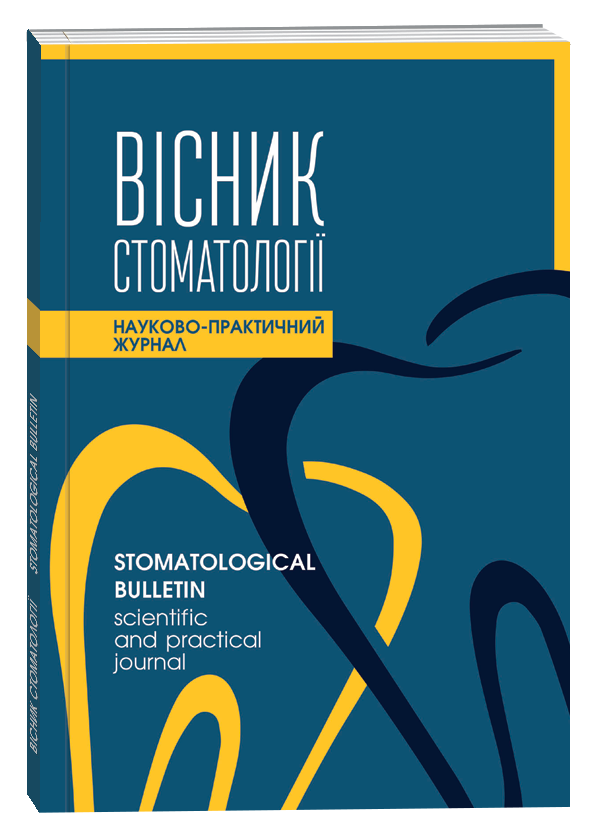STATE OF ORAL MICROBIOCENOSIS IN THE DYNAMICS OF TREATMENT OF PERI-IMPLANTITIS
DOI:
https://doi.org/10.35220/2078-8916-2023-49-3.10Keywords:
microbiocenosis, mucositis, peri-implantitis, gel, hyaluronic acid, photodynamic therapyAbstract
Before implantation treatment and in the rehabilitation period after it, it is necessary to conduct mandatory microbiological monitoring of the state of the oral biocenosis in these patients. Detection of certain microorganisms, assessment of their number and localization will allow predicting the course of lesions in the oral cavity, taking into account the nature of their pathogen, and taking preventive measures in advance using photodynamic therapy and a gel containing hyaluronic acid for complications after implantation. Purpose of the study. Study of the state of microbiocenosis in the oral cavity and in peri-implant tissues in the dynamics of treatment. Materials and methods of research. To solve this goal, we conducted a clinical and X-ray examination of 54 patients with periimplant mucositis and dental periimplantitub who were implanted with 76 implants with a maximum period after implantation of 7 years.the main contingent of patients belonged to the age group of 31-50 years (87.1 %). All patients were divided into two groups: the main group and the comparison group, and were also divided according to the statute of limitations for dental implantation. Conclusions. With dental peri-implantitis, there is an increase in opportunistic microflora, which has signs of pathogenicity, proteolytic and acidogenic properties, and bacteria that are not characteristic of the biocenosis appear. The use of a gel containing hyaluronic acid in combination with photodynamic therapy of the Helbo photodynamic System for the treatment of patients with dental peri-implantitis eliminates dysbiotic disorders and restores normobiosis in the oral cavity, which is manifested by the disappearance of symptoms of inflammation in the area of near-implant tissues.
References
Borysenko, A. V., Antonenko, M. Yu., Lynovytska, L. V., & et al. (2017). Stomatolohichni zakhvoriuvannia: terapevtychna stomatolohiia [Stomatological diseases: therapeutic stomatology]. Kyiv: Medytsyna. [in Ukrainian].
Tanner, A., Maiden, M.G., Macuch, P.J., Murray, L.L., & Kent Jr, R.L. (2008). Microbiotia of health, gingivitis and initial periodontitis. J. Clin. Periodontol, 2, 85-89 10.1111/j.1600-051x.1998.tb02414.x
Tsang, C., & Samaranayake, L. (2000). Salivary lysozyme and related parameters of a predominantly Chinese, HIV-infected cohort in Hong Kong. Oral. Dis, 5, 3, 241-246 doi: 10.1111/j.1601-0825.1999.tb00308.x.
Jenkins, W.M., & Papapanou, P.N. (2001). Epidemiology of periodontal disease in children and adolescents. Periodontol-2000. 26, 16–32 doi.org/10.1034/j.1600-0757.2001.2260102.x
Albandar, J.M. (2002). Global risk factors and risk indicators for periodontal diseases. Periodontol-2000, 29, 177-206 doi: 10.1034/j.1600-0757.2002.290109.x
Neely, A.L., Holford, T.R., Loe, H., Anerud, A., & Boysen, H. (2011). The natural history of periodontol disease in man. Risk factors for progression of attachment loss in individuals receiving no oral health care. J. Periodontol., 72, 8, 1006-1015 doi: 10.1902/jop.2001.72.8.1006.
Fábián, T.K., Fejérdy, P., & Csermely, P. (2008). Salivary genomics, transcriptomics and proteomics: The emerging concept of the oral ecosystem and their use in the early diagnosis of cancer and other diseases. Curr. Genomics., 9, 11–21 doi: 10.2174/138920208783884900.
Madhwani, T., & McBain, A.J. (2012). Compositional modification of nascent in vitro dental plaques by human host-defence peptides. FEMS Immunol. Med. Microbiol., 64, 3, 378-381 https://doi.org/10.1111/j.1574-695X.2011.00922.x
Yao, Y., Berg, E.A., Costello, C.E., Troxler, R.F., & Oppenheim, F.G. (2003). Identification of protein components in human acquired enamel pellicle and whole saliva using novel proteomics approaches. J. Biol. Chem., 278, 5300–5308.
Ogawa, Y., Miura, Y., Harazono, A., Kanai-Azuma, M., Akimoto, Y., & et al. (2011). Proteomic analysis of two types of exosomes in human whole saliva. Biol. Pharm. Bull., 34, 13–23. 11. doi: 10.1248/bpb.34.13.
Yamazaki K., Ueki-Maruayama K., Honda T., Nakajima T., & Seymour G.J. (2004). Effect of periodontal treatment on the serum antibody levels to heat shock proteins. Clin Exp Immunol.,135(3), 478–82 doi: 10.1111/j.1365-2249.2003.02375.x.
Pirnazar, P., Wolinsky, L., Nachnani, S., Haake, S., Pilloni, A., & Bernard, G.W. (1999). Bacteriostatic effects of Hyaluronic Acid. Journal of Periodontology., 70(4), 370-4.
Polepalle, T., Srinivas, M., Swamy, N., Aluru, S., Chakrapani, S., & Chowdary, B.A. (2015). Local delivery of hyaluronan 0.8% as an adjunct to scaling and root planing in the treatment of chronic periodontitis: A clinical and microbiological study. J Indian Soc Periodontol., 19, 37–42 doi: 10.4103/0972-124X.145807.
Mitra, S. (2019). Multiple Data Analyses and Statistical Approaches for Analyzing Data from Metagenomic Studies and Clinical Trials. Methods Mol Biol., 1910, 605-634 doi: 10.1007/978-1-4939-9074-0_20.








